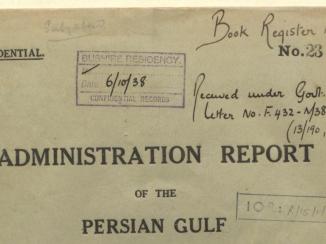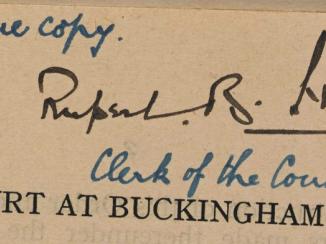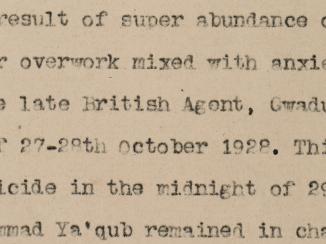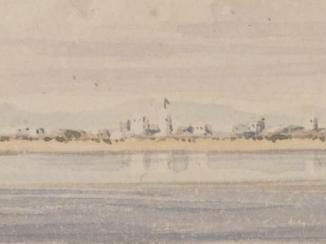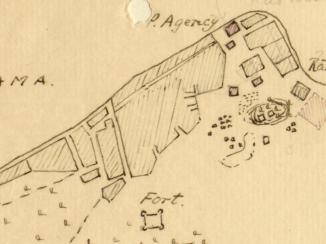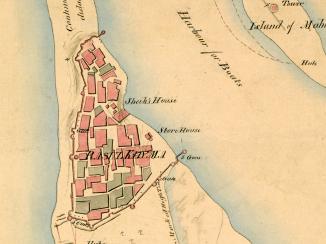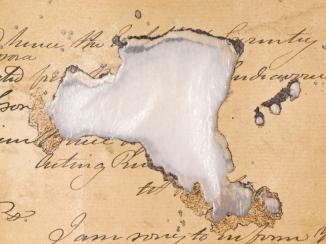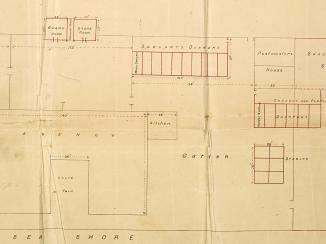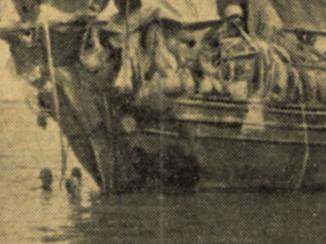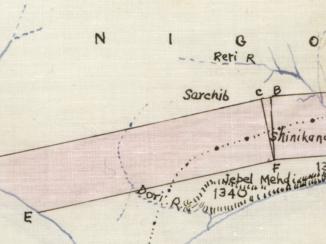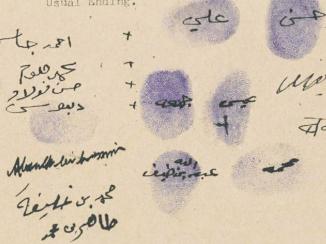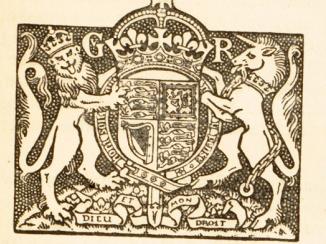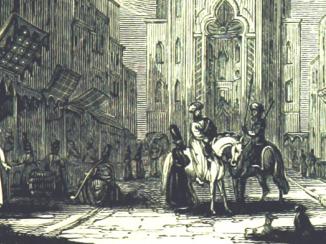Overview
Introduction
A letter from R. G. Daubeny, the Secretary at the British Residency An office of the East India Company and, later, of the British Raj, established in the provinces and regions considered part of, or under the influence of, British India. at Bushire, to the Political Agent A mid-ranking political representative (equivalent to a Consul) from the diplomatic corps of the Government of India or one of its subordinate provincial governments, in charge of a Political Agency. at Bahrain in January 1945, passes on a document that describes all aspects of office routine at Bushire. Daubeny states that the document had been prepared by the officiating Head Clerk at Bushire, Mr. K.V. Rajagopalan, and had formed the basis for a lecture delivered before the most recent batch of clerical recruits.
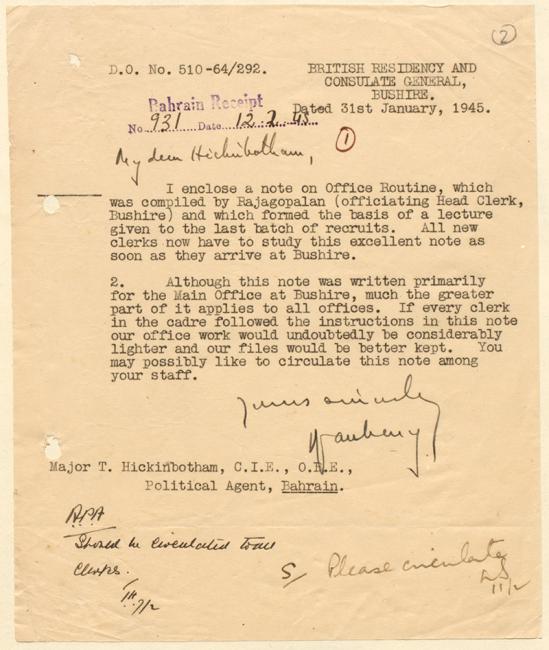
Daubeny describes the document as an ‘excellent note’, adding that: ‘If every clerk in the cadre followed the instructions in this note our office work would undoubtedly be considerably lighter and our files would be better kept.’ Despite the Secretary’s assessment and the comparatively late date of the document, Rajagopalan’s detailed instructions help explain many recurring features of the India Office The department of the British Government to which the Government of India reported between 1858 and 1947. The successor to the Court of Directors. files, and pay tribute to the work of the numerous clerks (often from British India) who staffed the various offices that together constituted the Persian Gulf The historical term used to describe the body of water between the Arabian Peninsula and Iran. Residency An office of the East India Company and, later, of the British Raj, established in the provinces and regions considered part of, or under the influence of, British India. .
The life stream of an office
In his note (IOR/R/15/2/1046, folios 3-16), the Head Clerk calls correspondence the ‘life stream of an office’, and goes on to describe in detail the procedure for dealing with both letters and telegrams as soon as they are received. The document notes that because of the prevailing wartime conditions in the 1940s, most of the correspondence at Bushire had to be carried out through telegram.
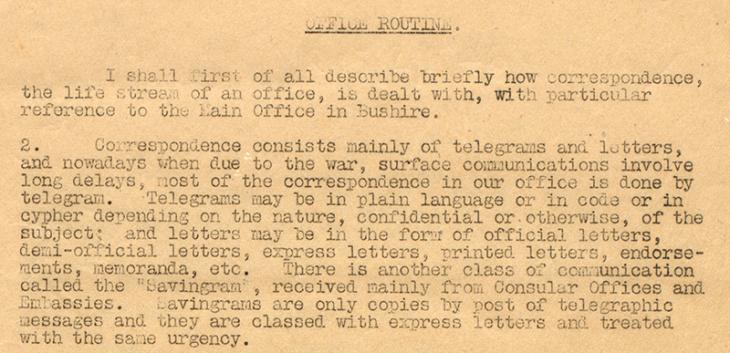
The correspondence process in detail
The procedure set out for handling correspondence was as follows: all received mail was entered into an ‘Inward Register’, stamped with the office seal, and given a serial number. It was then filed by the record keeper in the relevant file. The file was made up of two parts: the main body containing the correspondence, and the note sheets recording the orders on the various papers. The notes indicate how and why a certain action was decided upon for a particular paper.
Every item of correspondence placed in the main body of the file, whether issue or receipt, excluding enclosures, was given a serial number. This number was enclosed in a circle, and written in red ink or pencil for received correspondence, and in blue-black ink or blue pencil for issued correspondence, at the top of the first page of the paper. This circled number was never written in the top left corner of the page, as it would be difficult to see once the paper had been filed. Each serial was entered in the note sheets, giving the type of paper under consideration (letter, telegram, etc.), its number and date, and the name of the sender/addressee. The serial number was written above the entry in red or blue-black ink and circled. This process was called docketing.

The paper then had a paper under consideration (‘p.u.c.’) slip pinned to the top of the first page, before it was submitted to the relevant officer with a note referring to any previous correspondence, suggesting action to be taken, and including a draft where necessary. The officer recorded in the note sheets his orders on the various p.u.c.s submitted, which then went back to the office to be actioned.
If a draft was approved for issue, it went to the Telegram Clerk if a telegram, or to the Typist if it were to be prepared as a letter. Outward Registers were maintained, giving full details of all outgoing correspondence. Typescripts were checked and passed to the relevant officer (including the Political Resident A senior ranking political representative (equivalent to a Consul General) from the diplomatic corps of the Government of India or one of its subordinate provincial governments, in charge of a Political Residency. ) for signature. After that, the letter went to the Despatch Clerk.
Other information
The notes also covered the administrative structure of the Persian Gulf The historical term used to describe the body of water between the Arabian Peninsula and Iran. Residency An office of the East India Company and, later, of the British Raj, established in the provinces and regions considered part of, or under the influence of, British India. and its sub-offices, the work of the Typing Section, forms of letters and memoranda, the maintenance of the office’s records, the manner of noting and drafting (clerks’ notes should be ‘courteously written, but should not be servile in tone’), as well as the duties of the Telegram Clerk and the Despatch Clerk.
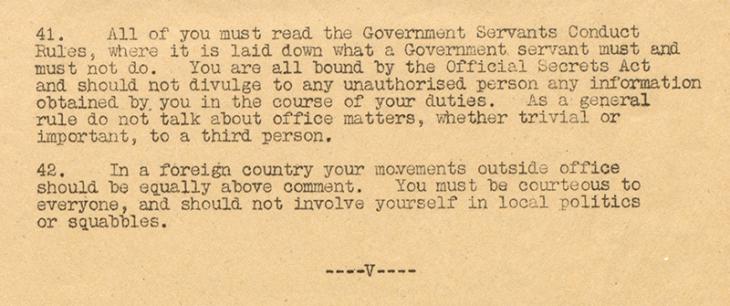
General advice for staff
Finally, the notes advised new recruits to the clerical establishment at Bushire to ‘read the Government Servants Conduct Rules, where it is laid down what a Government servant must and must not do.’ Staff were bound by the Official Secrets Act, and should not divulge information, whether trivial or important, to any unauthorised person. The document ends with salutary advice on how staff were to behave outside the office: ‘In a foreign country your movements outside office should be equally above comment. You must be courteous to everyone, and should not involve yourself in local politics and squabbles.’



